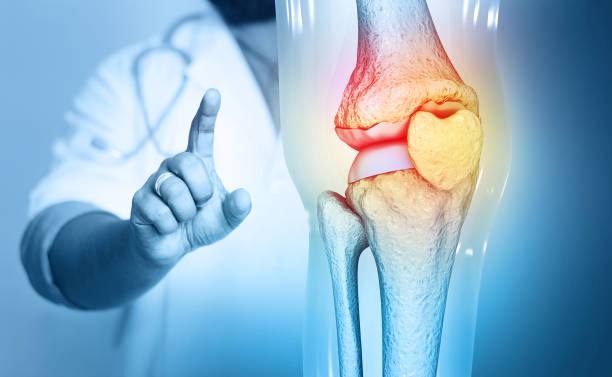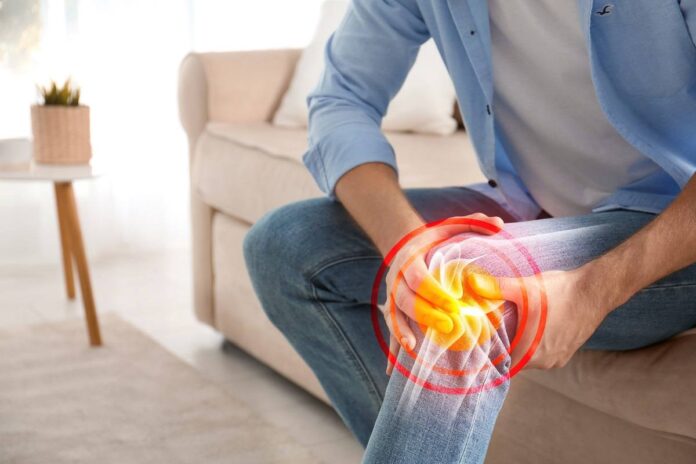The most prevalent kind of arthritis, often referred to as degenerative joint disease (DJD) and the medical name for a wide range of conditions characterised by joint inflammation, is osteoarthritis (OA). OA is a process that begins with the gradual destruction of cartilage, the smooth lining of a joint that reduces friction and absorbs shock. As the disease progresses gradually over the years, the cartilage cracks and flakes off, leading to pain and sometimes joint deformity. All joints may be affected, but it is most common in the fingers, ankles and feet, knees, hips, and spine (especially the neck and lower back).
More than 30 million Americans have osteoarthritis. As people age, they exhibit increasing signs of OA (as seen on X-rays), including a narrowing of the space naturally found in joints, a thinning of the cartilage at joint surfaces, changes in the texture of the cartilage from smooth to course, and the formation of bone spurs (overgrowths of bone). But people may never experience symptoms or not experience them until much later in life.
Typically OA has been divided into two types, but this division is thought of as artificial and may become obsolete as more underlying causes of the disease are discovered. Primary (also called idiopathic) osteoarthritis, which results from normal wear and tear associated with aging, most commonly affects thumb joints and the end joints of other fingers, as well as the hips, knees, neck, and lower spine. Secondary osteoarthritis is linked with some underlying condition, such as an injury to a joint, a disease such as gout, or abnormal stress on joints (due to obesity, posture problems, or occupational overuse, for example).
In some people symptoms of OA remain mild and follow a waxing-waning pattern. In others, symptoms grow progressively worse until they are disabling. Because the joints become stiff and painful, a person’s natural tendency is to minimize movement. Unfortunately, this can simply lead to a wasting of the muscles and to stiffer joints—and consequently more pain—since inactivity weakens the muscles that stabilize joints.
Table of Contents
Symptoms of osteoarthritis

For some people, symptoms remain mild or nonexistent, while for others, symptoms worsen to the point of becoming disabling. They include:
- Stiffness in the morning or after exercising.
- Joint stiffness and pain that is aggravated by movement, relieved by rest.
- Limited movement and loss of flexibility in the joints.
- Joint instability, in which, for instance, the knee gives way or buckles.
- Joint deformity in the finger, foot and knee joints (advanced osteoarthritis).
What causes osteoarthritis?
Many interrelated factors play a role in osteoarthritis. While time and long-term use may wear away the cartilage, the cushioning material of the joints, OA is known to be not simply wear and tear but a disease that prevents the cartilage from repairing and renewing itself normally. Aging is one of the strongest risk factors for OA, with more than 80 percent of people over age 55 having it versus almost none of those ages 25 to 34. Another strong risk factor is trauma to joints related to occupation as well as repetitive joint stress from, for example, sports or other physical activity. Obesity increases the risk of developing arthritis in the back, hips, and knees. There is also a link between diabetes and osteoarthritis.
Women have an almost three times higher risk of OA than men, and they are more likely to experience arapid deterioration in their joints. It’s not clear why women are at higher risk, but hormones may play a role. While there may be certain genetic factors that increase the risk of OA, it’s not clear how they interact with the other risk factors for the condition.
What if you do nothing?
For occasional mild joint pain and stiffness, there is no cause for concern since the symptoms typically clear in a matter of a few weeks. This is especially so if arthritis occurs in the fingers. However, if symptoms become more severe, especially if they affect your weight-bearing joints and therefore your daily activities, you may need to seek professional help.
Home remedies for osteoarthritis
First, see a doctor to make sure your problem really is osteoarthritis. There is no cure at present that can stop or reverse OA. You can, however, help slow the disease’s progress, decrease joint pain, and improve function with the following measures.
- Heat and cold. Cold packs, warm compresses, heat lamps, and warm baths or showers may bring periods of relief from the throbbing pain or stiffness associated with arthritis. Experiment with both cold and heat to see what works best. Apply the heat or cold to the painful joint for 20 minutes three times a day.
- Support the joint. A splint, brace, crutches, or cane may provide the support you need, eliminating or reducing stress on a painful affected joint.
- Exercise. A regular exercise program designed by your physician or a physical therapist is one of the few effective therapies recommended to slow down the development and progression of arthritis. The program should be aimed at restoring, maintaining, and increasing flexibility, muscle strength, and overall fitness. Excellent activities include tai chi, swimming, water aerobics, walking, and bicycling as well as strengthening (especially the thigh muscles, or quadriceps for lower extremity OA; a squeeze ball for OA of the fingers) and stretching exercises. For more on exercise for OA, see inset below.
- Lose weight. Increasing evidence indicates that extra weight damages the weight-bearing joints and speeds up the course of arthritis. Reducing your weight to acceptable levels may help stop or reverse the process.
- Capsaicin. Capsaicin creams can be beneficial for arthritis pain. Capsaicin, the substance that makes hot chili peppers hot, is an ingredient in some nonprescription salves and lotions. Capsaicin acts partly as a counterirritant and partly as a suppressant of pain impulses. Capsaicin creates a little diversionary pain that masks the real one, but it also blocks substance P, which is present in aching joints as part of the body’s pain-and-inflammation chemistry. You may need to use the cream three or four times daily, and you may not notice any improvement until you’ve applied the cream for a week or more.
- Medications (may be most effective). A number of drugs, including over-the-counter pain relievers, can ease arthritis pain. You may need to experiment to find the most effective drug and dosage. For mild symptoms, it’s worth trying low doses of acetaminophen (such as Tylenol) first, since it doesn’t carry the risk of stomach bleeding that nonsteroidal anti-inflammatory drugs (NSAIDs) such like naproxen (Aleve), ibuprofen (Advil, Motrin), and aspirin do. Note that acetaminophen should never be taken if you drink excessive amounts of alcohol, since that can result in serious liver damage. If acetaminophen doesn’t provide adequate relief, talk with your doctor about trying an NSAID. Note that there’s no evidence that NSAIDs slow the progression of disease.
Can osteoarthritis be prevented?
It’s not entirely clear how much OA can be prevented. But there is evidence showing that regular physical activity, such as walking or running, may have a protective effect against knee OA, perhaps by reducing pro-inflammatory chemicals in the knee that negatively impact joint health. There is also research suggesting that controlling blood sugar may be beneficial, since high blood sugar levels can make joints more sensitive to stress. You may be able to slow the progress of the disease by following the self-care measures outlined above. The most helpful measures are losing weight (if you are overweight), gradually starting an exercise program, avoiding any repetitive activities that can abnormally stress the joints, and seeking the care of a doctor, physical therapist, or other health care provider at the first sign of joint symptoms as a result of work or sports activities.
When to call your doctor
If joint pain or stiffness begin to interfere with daily activities, call your doctor.
What your doctor will do
Your doctor will take a history and perform a thorough exam of your joints to determine the presence and extent of arthritis. X-rays may be taken and, in rare cases, fluid may be drawn from an affected joint through a needle for analysis in a laboratory.
If you need pain relievers on a daily basis, you and your doctor should discuss the risks and benefits of different medications. If over-the-counter pain relievers don’t help enough, your doctor may suggest that you try a prescription NSAID, such as the COX-2 inhibitor celecoxib (Celebrex). An alternative to oral NSAIDs are topical NSAIDs, which can be applied as a patch or gel.
NSAIDs can cause gastrointestinal bleeding, increased risk of cardiovascular disease, and kidney or liver damage; acetaminophen also poses risks. So if you are taking any pain reliever on a long-term basis, you should get medical advice.
If none of these drugs is effective when combined with lifestyle measures, such as exercise and weight loss, your physician may recommend an intra-joint injection of corticosteroids. But these can worsen joint damage if used frequently.
Injections of hyaluronic acid, a lubricating compound naturally found in joints, or platelet rich plasma, a concentrated component of blood said to promote healing, may be recommended for knee osteoarthritis pain. Although hyaluronic acid may provide some pain relief in mild knee OA, it’s expensive, and the American Academy of Orthopaedic Surgeons doesn’t recommend it. Platelet rich plasma injections have shown promise in younger people with mild knee OA, but more high-quality studies are needed.
When joint pain and stiffness become severely debilitating, there is a range of surgical procedures that can make arthritis more tolerable, including partial or total joint replacement surgery . Each has its own benefits and limitations, and you should always be sure that the surgery is your best option. Fortunately, most people who have osteoarthritis will never need to have surgery.
For more information
- American College of Rheumatology
- Arthritis Foundation
- National Institute of Arthritis and Musculoskeletal and Skin Diseases




